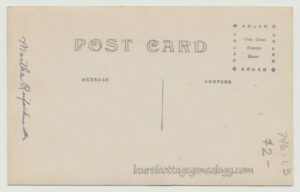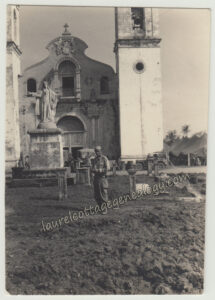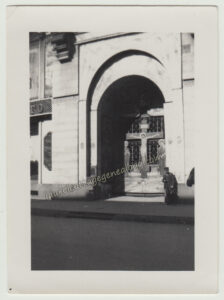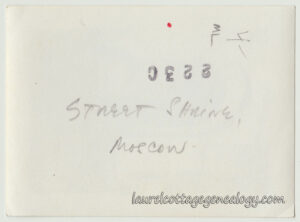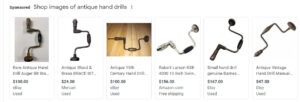.

Divided Back, Real Photo Postcard, unused. AZO stamp box. Photographer: Bicknell. Circa 1916 – 1918.
Price: $15.00
Embossed on the front lower right is the photographer info: “Bicknell. 326 1/2 Washington St. Portland Ore.”
Miss Lila, very smartly attired and posing rather somberly for the camera, was born in California, October 1894, the daughter of Benjamin F. Sears and Jennifer Wotton. She married Harry W. Kelley, May 7, 1921, in Portland. The date for this postcard has been narrowed down with the help of Playles.com (AZO stamp boxes all four triangles pointing upward are as late as 1918) and the photographer’s address.
The Bicknell Studio
The photography studio of Bicknell would have been Wilfred Bicknell and his wife, Pearl. They’re both listed as photographers on the 1910 Federal Census for Portland. He born in England about 1875, and she born in Oregon about 1881. The Portland city directories start online from 1906 for Wilfred; address 203 1/2 1st Street. By 1909 we’re seeing an additional address for the studio of 214 Merchants Trust Building, switching to 210 Merchants Trust by 1911. (No city directories were found for 1910.)
In 1919, Wilfred married Mayme H. Thuener, August 11, 1919 in Marin County, California. No records were found for a divorce or death for Pearl.
Curiously, no references were found for the 326 1/2 Washington Street, Portland address that’s embossed on the postcard.
When the WWI Draft Registration Card was recorded, Wilfred was in San Francisco, CA. This record shows his date of birth as December 28, 1874. He’s working as a photographer for employer, Charles Bossum at 25 Kearney St. Then 1920 census for Stockton, CA, shows Wilfred is as owner of a photography gallery.
By 1930, Wilfred has run into some tough times. At the time of this census, taken in Stockton, CA, he is a patient at the state mental hospital. (It makes one wonder how much exposure he may have had to chemicals and/or heavy metals from his occupation.)
Sources: “Real Photo Postcard Stamp Boxes, A – B.” https://www.playle.com/realphoto/photoa.php. (access April 23, 2023).
Oregon Center For Health Statistics; Portland, Oregon, USA; Oregon State Marriages, 1911-1945 (Ancestry.com).
Oregon State Archives; Salem, Oregon; Oregon, Death Records, 1864-1967. (Ancestry.com).
Year: 1910; Census Place: Portland Ward 5, Multnomah, Oregon; Roll: T624_1286; Page: 11A; Enumeration District: 0159; FHL microfilm: 1375299. (Ancestry.com).
R. L. Polk & Co.’s Portland, Oregon city directories, 1906 – 1916. (Ancestry.com).
Ancestry.com. California, U.S., Marriage Records from Select Counties, 1850-1941.
Ancestry.com. U.S., World War I Draft Registration Cards, 1917-1918.
Year: 1920; Census Place: Stockton Ward 4, San Joaquin, California; Roll: T625_144; Page: 2B; Enumeration District: 177. (Ancestry.com).
Year: 1930; Census Place: Stockton, San Joaquin, California; Page: 1B; Enumeration District: 0050; FHL microfilm: 2339947. (Ancestry.com).












